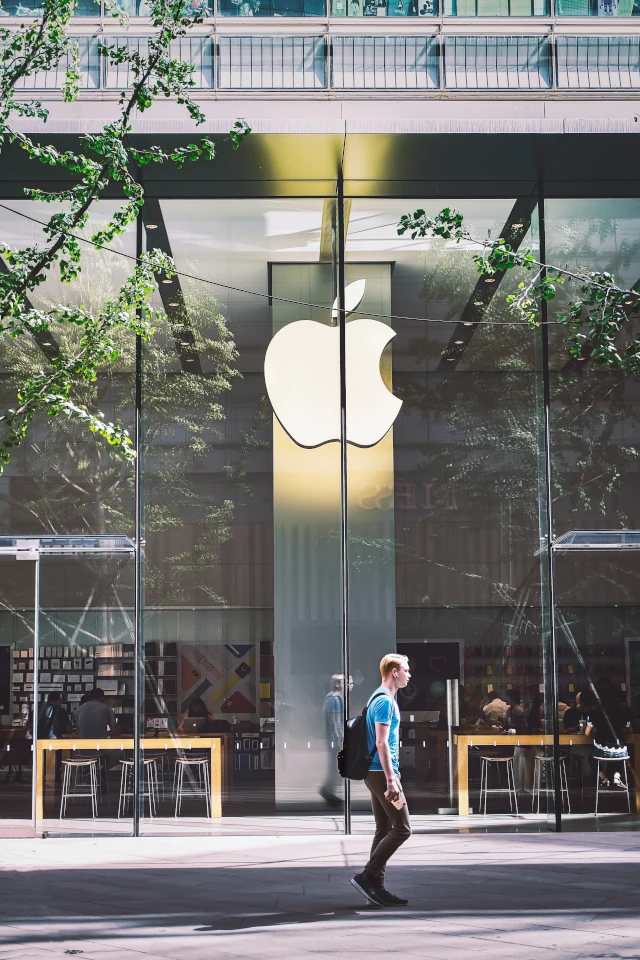Apple is more than just a tech company; it’s a phenomenon. With its sleek designs and a brand that’s synonymous with innovation, Apple has carved a unique place in consumer consciousness. But what really makes Apple’s marketing strategy stand out? In this blog post, we’ll uncover the core elements that define Apple’s marketing prowess.

Simplicity is the Ultimate Sophistication
At the heart of Apple’s marketing is a surprisingly simple mantra: simplicity. Apple’s product designs, user interfaces, and advertisements all epitomize this principle. The simplicity extends to its marketing strategy as well – clear, concise messages that resonate with the audience.
The company’s products are renowned for their clean, minimalist design. This simplicity in design is not just about aesthetics; it’s about making technology accessible and intuitive. The straightforward, user-friendly interfaces of Apple devices stand as a prime example. This design philosophy extends to Apple’s packaging, which is often just as iconic and minimalistic as the products themselves.
Its advertising campaigns are characterized by their clarity and minimalism. They typically feature plain backgrounds, focusing on the product and its functionality in a clear, concise manner. The ads avoid technical jargon, instead of highlighting how the product can enhance a user’s life. This approach makes Apple’s messaging easily digestible and memorable.
The brand messaging is all about simplicity and directness. Whether it’s a tagline like “Think Different” or product-specific messaging, Apple communicates in a way that is easy to understand and relate to. This straightforward communication helps in creating a strong, consistent brand image.
Simplicity in Apple’s marketing is ultimately aimed at underscoring the ease of use of its products. This is not just in the physical design but also in the user interface and customer journey. From setting up a new device to finding apps in the App Store, every interaction is designed to be straightforward and intuitive.
By making simplicity a core part of its marketing strategy, Apple has successfully created a brand that is not only easily recognizable but also highly appealing to a broad audience. This simplicity helps in demystifying technology, making Apple’s products more accessible and desirable to consumers worldwide.
Creating a Premium Brand
Apple has always positioned itself as a premium brand. This is not just through pricing but also through the quality and design of its products.
Apple’s journey to becoming a premium brand is a masterclass in strategic branding and marketing. Central to this achievement is their unwavering commitment to quality and innovation. Apple products, known for their sleek and elegant design, set a benchmark in the industry, showcasing the company’s focus on aesthetics and functionality. This emphasis on high-quality design extends beyond the product itself to its packaging, creating a holistic premium experience from the moment a customer unboxes their device.

The pricing strategy adopted by Apple plays a significant role in its premium branding. Unlike many competitors, Apple has consistently maintained high price points for its products. This approach creates an aura of exclusivity and luxury around the brand. Consumers perceive Apple products as high-end, not just because of their prices, but also due to the superior user experience and cutting-edge technology they offer. This perception is reinforced by Apple’s marketing campaigns, which focus on the lifestyle and experiences enabled by their products, rather than just technical specifications.
Another key element in Apple’s branding strategy is the customer experience. From the intuitive nature of its operating systems to the design of its Apple Stores, every touchpoint with the consumer is carefully curated. The Apple Stores, in particular, are more than just retail spaces; they are experiential hubs where customers can engage with products in a minimalist, aesthetically pleasing environment, assisted by knowledgeable staff. This level of customer service and support adds to the premium feel of the brand.
Apple’s consistent drive for innovation has cemented its status as a leader in the tech industry. Regular updates and new product releases keep the brand at the forefront of technological advancement, further enhancing its premium image. By successfully integrating exceptional design, a strategic pricing model, a unique customer experience, and a commitment to innovation, Apple has not just created products, but a distinct and desirable lifestyle choice, synonymous with luxury and quality.
Emphasizing Product Benefits, Not Features
Apple’s marketing strategy uniquely focuses on the benefits of its products rather than just their features, a tactic that has significantly contributed to its global success. This approach centers on how the products enhance and fit into the lifestyle of the consumer, rather than overwhelming them with technical specifications. For instance, when marketing the iPhone, Apple emphasizes the experiences enabled by the phone – capturing high-quality photos, staying connected with loved ones, or managing daily tasks with ease – rather than just listing its technical attributes.
This user-centric approach is evident in Apple’s advertising campaigns, which often feature real-life scenarios where Apple products add value. The ads tell stories that resonate with the audience, showcasing how the product seamlessly integrates into various aspects of life, whether it’s for work, entertainment, or personal growth. By doing so, Apple effectively communicates the practical and emotional benefits of their technology, creating a more compelling reason for consumers to invest in their products.
Apple’s emphasis on benefits over features simplifies the decision-making process for customers. Instead of needing to understand complex tech jargon, consumers are presented with clear, relatable, and compelling reasons why an Apple product might be right for them. This strategy not only makes Apple’s products more accessible to a broader audience but also strengthens the emotional connection between the brand and its customers.
Building an Ecosystem
Apple’s ecosystem is a pivotal aspect of its marketing strategy, playing a crucial role in cultivating brand loyalty and enhancing customer experience. This ecosystem, encompassing a range of devices, software, and services, is designed to work seamlessly together, offering users a cohesive and integrated experience. For instance, features like iCloud, Handoff, and AirDrop allow for a smooth transition between iPhone, iPad, and Mac, making daily tasks more efficient and user-friendly.
This interconnectedness not only simplifies the user experience but also creates a compelling reason for customers to stay within the Apple family of products. Once a user enters the Apple ecosystem, the convenience and functionality of having interconnected devices encourage continued investment in Apple products. This strategy effectively turns one-time buyers into loyal customers, as the value of the individual products is amplified when used in conjunction with others within the ecosystem.
Apple’s ecosystem supports a range of exclusive services and applications, further binding users to the brand. Services like Apple Music, Apple Pay, and the App Store offer unique benefits that are optimized for Apple devices. By continuously expanding and improving this ecosystem, Apple not only retains its existing customer base but also attracts new users seeking a seamless tech experience, thus reinforcing its market position and brand value.
Leveraging Secrecy and Hype
Apple masterfully utilizes secrecy and hype as strategic tools in its marketing, creating a sense of anticipation and excitement around its product launches. The company is known for its tight-lipped approach to new releases, with details about upcoming products zealously guarded. This secrecy fuels speculation and rumors in the tech community and among consumers, creating a buzz that keeps Apple in the headlines and its audience eagerly awaiting official announcements.

When it comes time to unveil a new product, Apple capitalizes on the built-up hype with highly choreographed launch events. These events are major happenings in the tech world, characterized by a blend of showmanship and detailed presentations by Apple executives. The reveal of each new product is treated as a significant moment, a spectacle that attracts not only tech enthusiasts but also widespread media coverage.
This strategy of secrecy and spectacle serves multiple purposes. Firstly, it positions Apple as an innovative and leading-edge company, with each product launch being a revelation in the tech space. Secondly, it creates a sense of exclusivity and privilege around owning Apple products. Lastly, by controlling the narrative around its product launches, Apple ensures that the focus remains on the strengths and unique features of its new offerings, driving consumer interest and demand.
Apple Stores – The Physical Embodiment of the Brand
Apple Stores are more than just retail outlets; they are the physical embodiment of the Apple brand. They provide an immersive experience where customers can interact with every product. The stores themselves are designed to be minimalist, stylish, and welcoming.
Apple Stores play a crucial role in the company’s marketing strategy, serving as much more than mere retail outlets. These stores are designed to embody the Apple brand, providing a physical space where customers can experience the ethos of Apple firsthand. The minimalist, aesthetically pleasing design of Apple Stores, with their open layouts and use of natural materials, reflects the simplicity and elegance of Apple products, creating a seamless brand experience.
The in-store experience is a key differentiator. Customers can interact directly with Apple’s entire product line, getting hands-on experience in a way that online shopping cannot replicate. This approach not only helps in showcasing the quality and usability of the products but also allows Apple to demonstrate the interconnectedness of its ecosystem in a tangible way.
Apple Stores provide a high level of customer service, with knowledgeable staff and the Genius Bar offering personalized assistance and technical support. This emphasis on customer service enhances customer satisfaction and loyalty, turning a simple purchase into a memorable experience. The stores also host workshops and events, further engaging the community and creating a sense of belonging among Apple users. Through these strategies, Apple Stores contribute significantly to the overall perception of the brand, reinforcing its status as a premium and customer-centric entity in the tech world.
A Strong Emphasis on Brand Storytelling
Brand storytelling is a cornerstone of Apple’s marketing strategy, playing a pivotal role in connecting emotionally with its audience. Apple’s storytelling doesn’t just focus on what its products can do; it emphasizes how these products fit into and enhance the lives of its customers. This narrative approach transforms Apple’s offerings from mere gadgets into integral components of a modern, aspirational lifestyle. For example, Apple’s commercials often depict real-life scenarios where individuals use its products to capture important life moments, create music, or stay connected with loved ones, thereby weaving its products into the fabric of everyday life.
Apple’s storytelling extends to its corporate narrative, including the legendary story of Steve Jobs and Steve Wozniak founding the company in a garage, symbolizing innovation, perseverance, and the American dream. This backstory adds layers of depth and personality to the brand, making it more relatable and inspirational.
By effectively telling stories, Apple creates a strong emotional bond with its customers. This strategy elevates the brand beyond its functional attributes, fostering a deep, loyal connection with its audience. It positions Apple not just as a technology provider but as a key player in the narrative of technological progress and personal empowerment, thereby significantly enhancing its brand appeal and loyalty.
Customer Loyalty and Community
Customer loyalty and community are integral to Apple’s marketing strategy, significantly contributing to the brand’s enduring success. Apple has cultivated a passionate and dedicated customer base, which not only repeatedly purchases its products but also serves as vocal brand advocates. This loyalty stems from a combination of Apple’s consistent product quality, its ecosystem’s interconnectivity, and the exclusive, aspirational brand image that Apple has successfully fostered.
The sense of community among Apple users is another key aspect of the company’s strategy. Apple encourages this community feeling through various means, such as hosting in-store events, workshops, and product launches that bring users together. Additionally, the seamless integration of Apple’s products encourages a shared user experience, fostering a sense of belonging among its customers.
This community and loyalty translate into powerful word-of-mouth marketing, with Apple enthusiasts often being the first to champion the brand’s new products and features. The trust and enthusiasm of these loyal customers are invaluable assets for Apple, not only in terms of repeat business but also in attracting new customers who aspire to be part of this exclusive community. Thus, the nurturing of customer loyalty and community is a strategic focus for Apple, reinforcing its brand strength and market position.
Consistent Innovation
Apple’s reputation as an innovator is a key part of its brand appeal. The company’s commitment to innovation ensures that it regularly offers new and improved products, keeping the brand fresh and relevant.
Consistent innovation is a hallmark of Apple’s marketing strategy, playing a critical role in maintaining the brand’s status as a leader in the technology industry. Apple’s commitment to innovation is evident in its continuous unveiling of groundbreaking products and features. Each new release, whether it’s an iteration of the iPhone, iPad, or Mac, often introduces pioneering technology or significant enhancements over previous models. This relentless pursuit of innovation not only reinforces Apple’s reputation for cutting-edge technology but also keeps its offerings fresh and relevant in a rapidly evolving market.
Apple’s marketing cleverly highlights these innovations, showcasing how new features can positively impact the daily lives of users. By focusing on the practical applications of its technological advancements, Apple ensures that even the most sophisticated innovations are relatable and desirable to a broad audience. This approach helps demystify technology, making it more accessible and appealing to consumers.
Apple’s consistent innovation fuels anticipation and excitement among its customer base and the broader market. Each announcement of a new product or feature becomes an event in itself, generating buzz and media attention. This cycle of innovation and anticipation not only drives sales but also solidifies Apple’s image as a pioneer and leader in the tech industry, crucial for sustaining its competitive edge and market dominance.
Apple’s Marketing Strategy in Summary
Apple’s marketing strategy is a blend of simplicity, storytelling, innovation, and creating a premium brand experience. It’s not just about selling products; it’s about creating an aura and a lifestyle that consumers want to be a part of. Apple’s success is a testament to the power of smart, strategic marketing.
- Simplicity in design and messaging.
- Positioning as a premium brand.
- Focusing on product benefits over features.
- Building a seamless ecosystem.
- Creating hype through secrecy.
- Experience-driven Apple Stores.
- Powerful brand storytelling.
- Cultivating a loyal community.
- Commitment to consistent innovation.
Understanding Apple’s marketing strategy offers valuable insights for businesses in any sector. It underscores the importance of brand perception, customer experience, and the power of a well-crafted story. Apple doesn’t just sell products; it sells an experience, and that’s the essence of its marketing genius.

